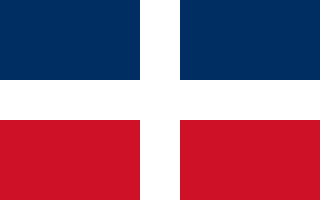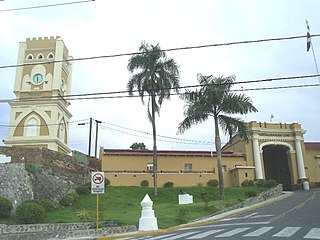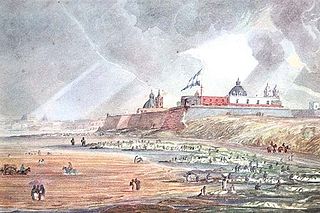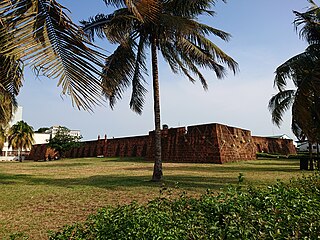
The recorded history of the Dominican Republic began in 1492 when Christopher Columbus, working for the Crown of Castile, arrived at a large island in the western Atlantic Ocean, later known as the Caribbean. The native Taíno people, an Arawakan people, had inhabited the island during the pre-Columbian era, dividing it into five chiefdoms. They referred to the eastern part of the island as Quisqueya, meaning 'mother of all lands.' Columbus claimed the island for Castile, naming it La Isla Española, which was later Latinized to Hispaniola.

San Francisco de Macorís is a city in the Dominican Republic located in the northeast portion of the island, in the Cibao region. It is the capital of the Duarte Province and the sixth most populated city in the country in 2010. The name San Francisco de Macorís comes from a combination of the name of Saint Francis, patron saint of the Franciscan Order and the territory's old name, which is Macorix.

The Military Government of Santo Domingo was a provisional military government established during the American occupation of the Dominican Republic that lasted from May 13, 1916 to September 18, 1924. The United States aimed to force the Dominicans to repay their large debts to European creditors, whose governments threatened military intervention. On May 13, 1916, Rear Admiral William B. Caperton forced the Dominican Republic's Secretary of War Desiderio Arias, who had seized power from President Juan Isidro Jimenes Pereyra, to leave Santo Domingo by threatening the city with naval bombardment.

The Banana Wars were a series of conflicts that consisted of military occupation, police action, and intervention by the United States in Central America and the Caribbean between the end of the Spanish–American War in 1898 and the inception of the Good Neighbor Policy in 1934. The military interventions were primarily carried out by the United States Marine Corps, which also developed a manual, the Small Wars Manual (1921), based on their experiences. On occasion, the United States Navy provided gunfire support and the United States Army also deployed troops.

12th Littoral Combat Team is an infantry unit in the United States Marine Corps based out of Marine Corps Base Camp Pendleton, California consisting of approximately 800 Marines and sailors. The unit falls under the command of the 12th Marine Littoral Regiment and the 3d Marine Division.

Ernest Calvin Williams was a United States Marine Corps officer who received the Medal of Honor for his actions on November 29, 1916, during the Battle of San Francisco de Macoris. Then 1st Lt Williams, leading 12 Marines, charged and captured the fortress from a numerically superior enemy. These actions were part of the U.S. occupation of the Dominican Republic. He was later awarded the Navy Cross.

Ciudad Colonial is the historic central neighborhood of the Dominican Republic's capital Santo Domingo. It is the oldest continuously inhabited European-established settlement in the Americas. The area has been declared a World Heritage Site by UNESCO. It is also known as Zona Colonial or more colloquially as "La Zona".

The Fort of São Sebastião de Caparica also known as the Tower of São Sebastião or Fortress of the Old Tower is a medieval fortification located in Monte da Caparica, civil parish of Caparica, in the municipality of Almada, in the Portuguese central region of Península de Setúbal.

The Dominican Army, is one of the three branches of the Armed Forces of the Dominican Republic, together with the Navy and the Air Force.

The Ozama Fortress, also formerly known as the city wall's Homage tower, is one of the surviving sections of the Walls of Santo Domingo, which is recognized by UNESCO as being the oldest military construction of European origin in the Americas. It was built between 1502–1508 by the Spanish at the entrance to Santo Domingo's Ciudad Colonial, Dominican Republic, and overlooking the Ozama River. Named after this river, the castle, also referred to as "La Fortaleza" or "The Fortress". It was declared by UNESCO as a World Heritage Site, together with the other historical monuments of the Ciudad Colonial.

The Fortaleza San Felipe is a historic Spanish fortress located in the north of the Dominican Republic in the province of Puerto Plata. Also known as El Morro de San Felipe, it was used to protect the City of Puerto Plata from foreign invaders, pirates, and privateers. It is located on a hill at the Puntilla del Malecón, overlooking the entrance to the city's seaport.

La Trinitaria was a secret society founded in 1838 in what today is known as Arzobispo Nouel Street, across from the "Del Carmen's Church" in the then occupied Santo Domingo, the current capital of the Dominican Republic. The founder, Juan Pablo Duarte, and a group of like minded young people, led the struggle to establish the Dominican Republic as a free, sovereign, and independent nation in the 19th century. Their main goal was to protect their newly liberated country from all foreign invasion. They helped bring about the end of the Haitian occupation of Santo Domingo from 1822 to 1844.

Fortaleza San Luis is located near the Yaque del Norte River in southwest Santiago de los Caballeros, Dominican Republic. The Fort was the location of several battles during the War of Restoration. Fortaleza San Luis has also served as a Municipal Prison and more recently the fort has been converted into a Museum.

The Fortaleza de Santa Teresa, or Fortaleza Santa Tereza is a military fortification located 36 km (22 mi) south of Chuy and 305 km (190 mi) northeast of Montevideo on Route 9, in the Rocha Department of eastern Uruguay. It lies about 800 m (2,600 ft) from the coast at Playa la Moza, almost halfway between Angostura and La Coronilla , north of Punta del Diablo and roughly 4 km (2.5 mi) northeast of the northeast bank of the Laguna Negra. It lies within the Santa Teresa National Park. It was erected from October 1762 by the Portuguese, having abandoned the attempt at building a fort in Maldonado and leaving the Fuerte San Miguel.

Tourism in the Dominican Republic is an important sector of the country's economy. More than 10 million tourists visited the Dominican Republic in 2023, making it the most popular tourist destination in the Caribbean and putting it in the top 5 overall in the Americas. The industry accounts for 11.6% of the nation's GDP and is a particularly important source of revenue in coastal areas of the country. The nation's tropical climate, white sand beaches, diverse mountainous landscape and colonial history attracts visitors from around the world. In 2022, the nation's tourism was named the best-performing nation since the height of the pandemic with over 5% visitors more in comparison to pre-pandemic levels in 2019.
The Battle of Guayacanas was fought on 3 July 1916 between Dominican rebels and the United States during the United States occupation of the Dominican Republic. The Dominicans dug trenches on two hills blocking passage to Santiago and kept up single-shot fire against the automatic weapons of the Americans before the Americans drove them off. Joseph A. Glowin, a corporal, was awarded the Medal of Honor for his bravery during the action.

The Fort of Buenos Aires was a fortress destined to defend Buenos Aires and to be the seat of the Spanish colonial authorities in the city. Its construction began in 1595 and after several refurbishments it was finished only at the beginning of the 18th century, being demolished in 1882. It received the name of Real Fortaleza de Don Juan Baltasar de Austria, and in the 17th century it was called Castillo de San Miguel Arcángel del Buen Ayre.

The Fort Nossa Senhora da Conceição of Lourenço Marques, nowadays known as the Maputo Fortress is located at Praça 25 de Junho and represents one of the main historical monuments of the city of Maputo, former Lourenço Marques, in Mozambique.

The Battle of Santiago (1863) was a battle during the Dominican Restoration War. On September 6, 1863, during the Restoration War, after an intense battle, the Spanish annexationist forces managed to enter the Plaza de Armas in Santiago. The Spanish were commanded by General Juan Suero and Colonel Manuel Cappa, who had entered Santiago with a column of three thousand men from Puerto Plata. The Spanish troops totaled 900 men, with other commanders consisting of Brigadier Manuel Buceta, Generals Hungría, Alfau and Achile Michel and gunner José María López. The days prior to the battle, the restoration troops commanded by Gregorio Luperón, Benito Monción, Gregorio de Lora and Gaspar Polanco had surrounded the city of Santiago, forcing the withdrawal of about a thousand Spanish soldiers who had arrived from Puerto Plata to reinforce the annexationist troops. This battle, however, was not without casualties. In the battles of Santiago, in addition to General Gregorio de Lora, other Dominican officers died. The Spanish also killed General Luperón's horse.




















